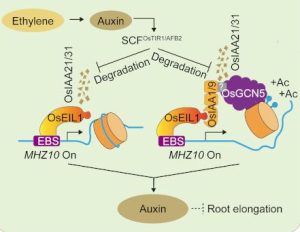Auxin–ethylene interactions in rice roots
Zhou et al. explore the links between ethylene and auxin responses in rice. https://doi.org/10.1093/plcell/koac250
Background: The phytohormones ethylene and auxin play important roles in developmental regulation and environmental acclimation in plants. Ethylene promotes the accumulation of the master transcription regulators ETHYLENE INSENSITIVE3/EIN3-LIKE1 (EIN3/EIL1). Auxin triggers the degradation of Auxin/Indole-3-Acetic Acid proteins to release AUXIN RESPONSE FACTORs for downstream regulation. Although the biosynthesis and signaling pathways of these two phytohormones have been intensively studied, how, when, and where they crosstalk is still poorly understood, especially in rice.
Question: Are there more links between ethylene and auxin at the levels of biosynthesis and signaling?
 Findings: Through an analysis of a root-insensitive ethylene response mutant mao hu zi 10 (mhz10), we identified the key tryptophan aminotransferase MHZ10/TRYPTOPHAN AMINOTRANSFERASE OF ARABIDOPSIS1-RELATED (OsTAR2) participating in the auxin biosynthesis pathway. OsTAR2 is directly upregulated by OsEIL1. Interestingly, we detected no ethylene induction of OsTAR2 expression in the mutant roots, and discovered a positive feedback loop between auxin and ethylene for the regulation of OsEIL1-mediated OsTAR2 transcriptional activation. Further studies revealed that OsEIL1 interacts with OsIAA1/9/21/31. OsIAA21/31 repressed OsEIL1 activity through histone deacetylation at the OsTAR2 locus. The EAR motif and surrounding sequences of OsIAA1/9 recruits OsGCN5 for histone acetylation. This OsIAA1/9-mediated histone acetylation promotes OsEIL1-mediated OsTAR2 induction. Moreover, the auxin receptors OsTIR1/AFB2 mediate a faster degradation of OsIAA21/31 than of OsIAA1/9, thus allowing the release and promotion of OsEIL1 activity.
Findings: Through an analysis of a root-insensitive ethylene response mutant mao hu zi 10 (mhz10), we identified the key tryptophan aminotransferase MHZ10/TRYPTOPHAN AMINOTRANSFERASE OF ARABIDOPSIS1-RELATED (OsTAR2) participating in the auxin biosynthesis pathway. OsTAR2 is directly upregulated by OsEIL1. Interestingly, we detected no ethylene induction of OsTAR2 expression in the mutant roots, and discovered a positive feedback loop between auxin and ethylene for the regulation of OsEIL1-mediated OsTAR2 transcriptional activation. Further studies revealed that OsEIL1 interacts with OsIAA1/9/21/31. OsIAA21/31 repressed OsEIL1 activity through histone deacetylation at the OsTAR2 locus. The EAR motif and surrounding sequences of OsIAA1/9 recruits OsGCN5 for histone acetylation. This OsIAA1/9-mediated histone acetylation promotes OsEIL1-mediated OsTAR2 induction. Moreover, the auxin receptors OsTIR1/AFB2 mediate a faster degradation of OsIAA21/31 than of OsIAA1/9, thus allowing the release and promotion of OsEIL1 activity.
Next steps: More findings highlighting ethylene-auxin interactions are expected. In addition to the activity of the key transcription regulator OsEIL1 in this study, its protein turnover appears to be also modulated by the auxin pathway. Considering this point, is there a desensitization/balance mechanism after sufficient auxin biosynthesis has been attained for regulating long-term root growth in response to ethylene?
Reference:
Yang Zhou, Biao Ma, Jian-Jun Tao, Cui-Cui Yin, Yang Hu, Yi-Hua Huang, Wei Wei, Pei-Yong Xin, Jin-Fang Chu, Wan-Ke Zhang, Shou-Yi Chen, Jin-Song Zhang (2022). Rice EIL1 interacts with OsIAAs to regulate auxin biosynthesis mediated by the tryptophan aminotransferase MHZ10/OsTAR2 during root ethylene responses. Plant Cell. https://doi.org/10.1093/plcell/koac250



